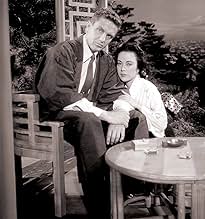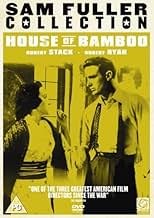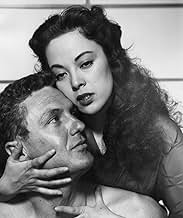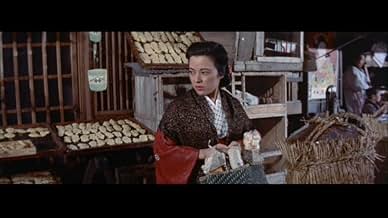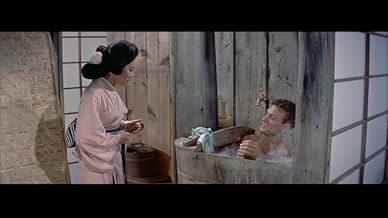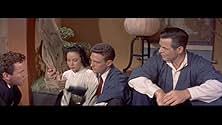IMDb RATING
6.8/10
4.3K
YOUR RATING
Planted in a Tokyo crime syndicate, a U.S. Army Investigator attempts to probe the coinciding death of a fellow Army official.Planted in a Tokyo crime syndicate, a U.S. Army Investigator attempts to probe the coinciding death of a fellow Army official.Planted in a Tokyo crime syndicate, a U.S. Army Investigator attempts to probe the coinciding death of a fellow Army official.
Clifford Arashiro
- Policeman
- (uncredited)
Sandy Azeka
- Charlie's Girl at Party
- (uncredited)
Harry Carey Jr.
- John
- (uncredited)
Barry Coe
- Captain Hanson's Aide
- (uncredited)
John Doucette
- Skipper
- (uncredited)
Fuji
- Pachinko Manager
- (uncredited)
Samuel Fuller
- Japanese policeman
- (uncredited)
Peter Gray
- Willy
- (uncredited)
- Director
- Writers
- All cast & crew
- Production, box office & more at IMDbPro
Storyline
Did you know
- TriviaAccording to Robert Stack, Samuel Fuller told an actor to go down really low when he passed a 50-gallon drum. Without informing the actor, the director had a sharpshooter on a parallel who shot over the man's head and into the drum. After it blew up, the actor said, "Jesus Christ! Those were real bullets!" Fuller laconically replied, "Don't worry. He knew what he was doing."
- GoofsSandy fires an awful lot of shots from his pistol (which is a revolver) without ever appearing to reload it.
- Quotes
Sandy Dawson: Who are you working for?
Eddie Kenner: [posing as Eddie Spanier] Spanier.
Sandy Dawson: Who's Spanier?
Eddie Kenner: Me.
Sandy Dawson: Who else you working for?
Eddie Kenner: Eddie.
- ConnectionsEdited into Shock Corridor (1963)
Featured review
No need to recap the plot. The movie's one-third caper film, one-third romance, and one- third travelogue. Cult filmmaker Fuller tries to bring them together, but only partially succeeds, despite that colorful climax with the revolving globe and the rooftop view of Tokyo. Two of Fuller's usual concerns prevail here as elsewhere—culture clash and military organization.
Mariko and Eddie must work through their cultural differences before establishing a real relationship. Screenwriter Fuller spends a lot of time with this, maybe too much since it drags out the pacing. However, I suspect he was revealing a timely cultural glimpse to American audiences—remember this was less than a decade after the war and, generally, Americans knew very little about their new Cold War partners or traditional Japanese society.
Surprisingly, the robbery capers are dealt with only briefly and without the expected rising tension. In fact, Fuller seems more interested in the para- military discipline that defines the gang than in the robberies themselves, an aspect that produces more talk than action. Getting the great Robert Ryan (Sandy) as the gang's "5-star general" was the real casting coup since it's his fierceness that delivers the film's main impact. (In passing—Griff's {Mitchell} attachment to Sandy appears ambiguous enough to be interesting for the time.)
Frankly, I liked the travelogue parts best. Fuller does a good job working these into the story, while the scenes themselves of Japanese landmarks and street crowds are colorful as heck. Anyway, the movie's too uneven and diffuse to have real impact. Still, it does remain a visual treat despite the passing decades.
Mariko and Eddie must work through their cultural differences before establishing a real relationship. Screenwriter Fuller spends a lot of time with this, maybe too much since it drags out the pacing. However, I suspect he was revealing a timely cultural glimpse to American audiences—remember this was less than a decade after the war and, generally, Americans knew very little about their new Cold War partners or traditional Japanese society.
Surprisingly, the robbery capers are dealt with only briefly and without the expected rising tension. In fact, Fuller seems more interested in the para- military discipline that defines the gang than in the robberies themselves, an aspect that produces more talk than action. Getting the great Robert Ryan (Sandy) as the gang's "5-star general" was the real casting coup since it's his fierceness that delivers the film's main impact. (In passing—Griff's {Mitchell} attachment to Sandy appears ambiguous enough to be interesting for the time.)
Frankly, I liked the travelogue parts best. Fuller does a good job working these into the story, while the scenes themselves of Japanese landmarks and street crowds are colorful as heck. Anyway, the movie's too uneven and diffuse to have real impact. Still, it does remain a visual treat despite the passing decades.
- dougdoepke
- May 26, 2011
- Permalink
- How long is House of Bamboo?Powered by Alexa
Details
- Release date
- Country of origin
- Languages
- Also known as
- The Tokyo Story
- Filming locations
- Tokyo, Japan(rooftop playground of the Matsuma department store)
- Production company
- See more company credits at IMDbPro
Box office
- Budget
- $1,380,000 (estimated)
- Runtime1 hour 42 minutes
- Aspect ratio
- 2.55 : 1
Contribute to this page
Suggest an edit or add missing content





